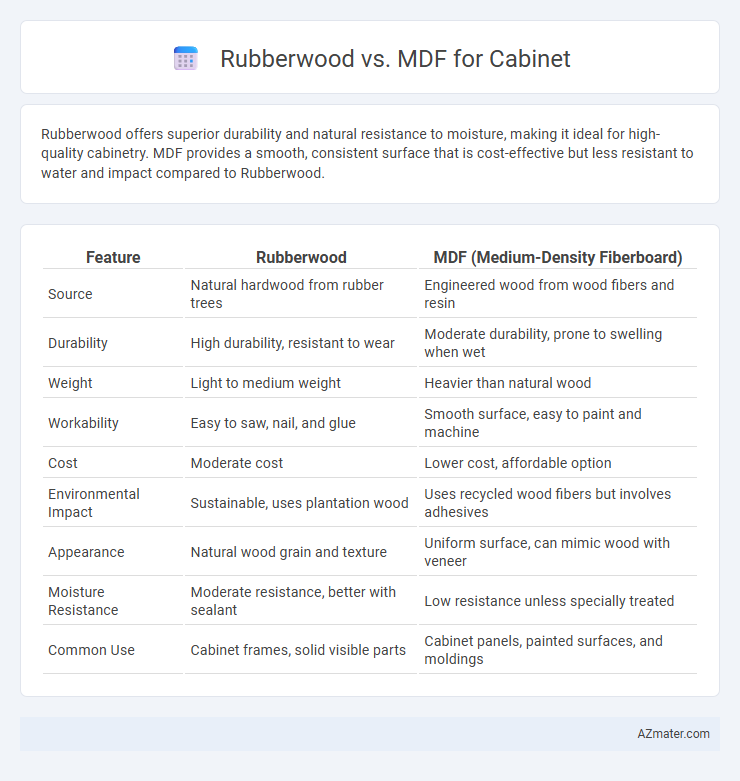Rubberwood offers superior durability and natural resistance to moisture, making it ideal for high-quality cabinetry. MDF provides a smooth, consistent surface that is cost-effective but less resistant to water and impact compared to Rubberwood.
Table of Comparison
| Feature | Rubberwood | MDF (Medium-Density Fiberboard) |
|---|---|---|
| Source | Natural hardwood from rubber trees | Engineered wood from wood fibers and resin |
| Durability | High durability, resistant to wear | Moderate durability, prone to swelling when wet |
| Weight | Light to medium weight | Heavier than natural wood |
| Workability | Easy to saw, nail, and glue | Smooth surface, easy to paint and machine |
| Cost | Moderate cost | Lower cost, affordable option |
| Environmental Impact | Sustainable, uses plantation wood | Uses recycled wood fibers but involves adhesives |
| Appearance | Natural wood grain and texture | Uniform surface, can mimic wood with veneer |
| Moisture Resistance | Moderate resistance, better with sealant | Low resistance unless specially treated |
| Common Use | Cabinet frames, solid visible parts | Cabinet panels, painted surfaces, and moldings |
Introduction: Rubberwood vs MDF for Cabinets
Rubberwood, known for its durability and natural resistance to moisture, offers a sustainable choice for cabinet construction, providing a sturdy and eco-friendly alternative. MDF (Medium Density Fiberboard) is engineered for smooth surfaces and precise finishes, ideal for painted or laminated cabinets in controlled environments. Understanding the differences in strength, moisture resistance, and environmental impact helps determine the best material for specific cabinetry needs.
Material Overview: What Is Rubberwood?
Rubberwood, also known as parawood, is derived from the Para rubber tree (Hevea brasiliensis) primarily after the latex-producing cycle ends, making it an eco-friendly and sustainable material. Its hardwood characteristics offer durability and a natural grain, making it highly suitable for cabinets that require strength and aesthetic appeal. Compared to MDF, rubberwood provides superior resistance to wear and impact, maintaining structural integrity in furniture applications.
Material Overview: What Is MDF?
MDF, or Medium Density Fiberboard, is an engineered wood product made from wood fibers combined with resin and compressed under heat and pressure to form dense, uniform panels. It offers a smooth surface ideal for painting and veneering, making it a popular choice for cabinetry where a flawless finish is desired. Compared to natural woods like rubberwood, MDF provides greater stability with less risk of warping or cracking, though it is less resistant to moisture and may require sealing in cabinet applications.
Durability: Comparing Rubberwood and MDF
Rubberwood boasts superior durability with its dense hardwood structure, offering excellent resistance to wear, impact, and moisture compared to MDF. MDF, composed of wood fibers and resin, is more susceptible to swelling, warping, and denting under heavy use or exposure to humidity. For cabinet applications requiring long-term strength and structural integrity, rubberwood provides a more reliable and resilient choice than MDF.
Appearance and Finish Options
Rubberwood offers a natural grain pattern and warm, light color that enhances cabinet aesthetics with a classic, traditional look, suitable for staining or clear finishes. MDF provides a smooth, uniform surface ideal for painted finishes, enabling vibrant colors and a sleek, modern appearance without visible grain. Both materials allow diverse finishing options, but Rubberwood's texture appeals to those seeking a natural wood look, while MDF excels in customizable, flawless painted cabinetry.
Workability and Customization
Rubberwood offers superior workability for cabinets due to its natural grain, allowing easy sanding, staining, and shaping for intricate designs. MDF provides exceptional customization, boasting a smooth, uniform surface ideal for detailed painting, laminating, and veneering that rubberwood can't consistently achieve. While rubberwood excels in durability and natural aesthetics, MDF's consistency facilitates precision cuts and complex profiles, making both materials favorable depending on project requirements.
Environmental Impact and Sustainability
Rubberwood cabinets are favored for sustainability due to their use of plantation-grown trees harvested after latex production, reducing deforestation and promoting renewable resources. MDF (Medium Density Fiberboard) often contains formaldehyde-based resins and relies on wood fibers from various sources, raising concerns about chemical emissions and limited recyclability. Choosing rubberwood supports eco-friendly practices with lower carbon footprints and biodegradability, while MDF's environmental impact depends heavily on resin type and manufacturing standards.
Cost Comparison: Rubberwood vs MDF
Rubberwood cabinets generally cost more than MDF due to the natural hardwood qualities and durability, with prices varying between $50 to $150 per sheet compared to MDF's $30 to $80 per sheet. MDF, made from wood fibers and resin, offers a budget-friendly option that is easier to machine but tends to be less durable and more prone to moisture damage than rubberwood. The cost difference reflects material longevity, with rubberwood cabinets often providing better long-term value despite higher upfront investment.
Maintenance and Longevity
Rubberwood cabinets offer superior longevity due to their natural resistance to cracking and warping, requiring minimal maintenance such as occasional polishing to preserve their durability. MDF cabinets, while more affordable, need protective finishes to prevent moisture damage and can require frequent touch-ups to maintain their appearance over time. Proper care of Rubberwood ensures it remains structurally sound for decades, whereas MDF may deteriorate faster in humid environments without consistent upkeep.
Best Choice: Which Material Is Right for Your Cabinets?
Rubberwood offers superior durability and natural resistance to warping, making it an excellent choice for sturdy, long-lasting cabinets. MDF provides a smooth, uniform surface ideal for painted finishes but lacks the strength and moisture resistance of solid wood. For cabinets requiring structural integrity and a natural wood aesthetic, rubberwood is the best choice, while MDF suits budget-friendly projects with intricate painted designs.

Infographic: Rubberwood vs MDF for Cabinet
 azmater.com
azmater.com